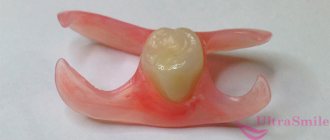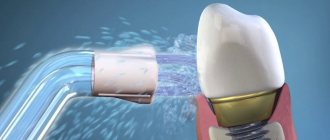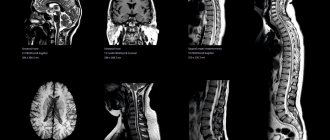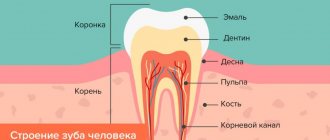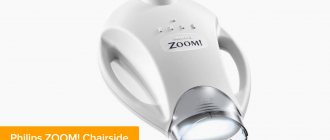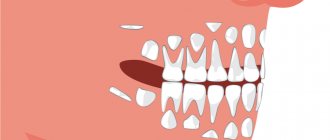For a couple of decades, patients of dental clinics who were not classified as VIPs had access to only 3 main services:
- dental treatment;
- deletion;
- prosthetics.
Today the range of services has expanded significantly. If the patient comes to the doctor on time, he will be able (in most cases) to save his teeth and avoid multiple dentures. It is interesting that even for people suffering from periodontitis, which previously almost guaranteed to lead to the loss of practically healthy teeth, in our time there are ways to restore health to the gums and stop the process of thinning of bone tissue.
One of the new methods that prevents and relieves gum inflammation is cleaning with the Vector device. Let's figure out what this technique is.
Indications
Vector teeth cleaning is, in essence, a treatment. Using the device, the doctor cleans and polishes the crowns, and also specifically affects the gums and subgingival pockets (if they have already formed).
How does the Vector device work?
Main indications:
- tartar (the device effectively removes deposits in the most inaccessible places);
- soft coating;
- gingivitis;
- periodontitis;
- periodontal disease.
“Vector” gives a real chance to eliminate the symptoms of inflammatory gum diseases, stops destructive processes, and therefore the technique is in demand among patients who find it difficult to clean and whiten their teeth using other methods.
Acute inflammation (occurs when periodontal pockets suppurate, gums are damaged by a tooth fragment or a crown) is an obstacle for many of them. “Vector” is approved for use.
Cleaning process
Using Vector, patients get by with 2-3 cleaning procedures. There is no need for surgical intervention when a gum flap is sewn to the tooth, eliminating the periodontal pocket. When cleaning, the affected tissue is removed, and the gum itself fits tightly to the tooth again.
How to clean
Before using the Vector device in action, the specialist applies application anesthesia to the patient’s gums. The procedure itself is painless, but this is done for greater comfort and complete elimination of discomfort, as well as taking into account the individual characteristics of people with a low pain threshold.
The doctor places the device attachment at a short distance from the surface of the teeth and gums, that is, all manipulations are non-contact. When the device is turned on, it produces ultrasonic waves that split and crush into small fragments even the hardest deposits that adhere tightly to the teeth. At the same time, a liquid is introduced into the oral cavity, washing away plaque and thoroughly polishing all areas.
It takes 4-5 minutes to treat one tooth. Complete cleaning of the teeth usually takes about one and a half hours. But for some, the procedure goes a little faster, and for some patients, on the contrary, it lasts longer. It all depends on the clinical situation, the amount and depth of periodontal deposits.
On a note! For some patients, the doctor prescribes a course of procedures using the Vector device, others get rid of plaque in just one visit to the clinic, and then simply maintain the result every 2-4 months.
Advantages and disadvantages
Does your doctor recommend brushing your teeth with Vector? Agree. Advantages of such cleaning:
- painlessness;
- the ability to remove well-camouflaged deposits;
- preparation of deep periodontal pockets;
- low traumatic.
There are much fewer cons. Doctors complain that it is not always possible to remove tartar from all sides. Occasionally (when using unsuitable attachments), the patient suffers injury to nearby tissues. But such a situation is not excluded even with simple ultrasonic cleaning. That's all the negative sides of manipulation.
Treatment with the “Vector” device
The ultrasonic cleaning system is suitable for the treatment of various types of gum diseases: periodontal disease, periodontitis, gingivitis.
Periodontal disease
Good news for those suffering from periodontal disease: “Vector” not only removes tartar, but also allows you to stop the destructive process.
Periodontal disease is not as common in dental practice as periodontitis, but anyone who has problems with the tissues surrounding the tooth is at risk. With periodontal disease, there is no inflammation as such, but there is dystrophic destruction of the periodontal tissues.
The gums undergo recession. Advanced periodontitis leads to periodontal disease. The disease is more often diagnosed in elderly patients in whom pathological changes are caused by age-related characteristics.
Periodontal disease leads to tooth loss. Due to thinning of the bone tissue, it is then difficult to place dentures.
Periodontitis
Periodontitis develops due to:
- poor oral hygiene;
- untreated gingivitis;
- malocclusion;
- crowded teeth;
- the presence of hard dental plaque.
At first, it bothers you at times, manifesting itself as pain when trying to eat sweet, cold or hot food. The gums become red or bluish and bleed.
If the disease is not treated, the gum tissue gradually separates from the crown, forming a pocket where bacteria can enter. The patient feels pain, others feel an unpleasant odor emanating from the inflamed pockets.
Using the Vector ultrasonic cleaning system, the doctor:
- removes diseased tissue;
- treats inflamed areas and pockets, as a result of which the gums fit tightly to the teeth again;
- polishes teeth after the procedure.
In 1-2 sessions you can get rid of exacerbation of periodontitis. Then you need to come for preventive examinations and repeat treatment if the dentist discovers a relapse of the disease.
Gingivitis
Gingivitis is the easiest thing to deal with. Having cured the gums at the stage of gingivitis, a person will not encounter such complications as periodontitis.
Symptoms of gingivitis:
- bad breath;
- cyanosis of the gums (redness);
- inflammation of the interdental papillae.
There are no pockets yet - it is enough to clean them once with Vector so that they never appear.
What can you say about the benefits?
The advantage is that cleaning with the Vector device allows you to remove deposits deeply embedded under the gums. In this case, the procedure is non-contact, in the most gentle manner, and in some cases (initial and middle stage periodontitis) even allows you to do without surgical curettage of the gums. During the process, the roots of the teeth are thoroughly polished, which is very important for patients with periodontitis, because if the roots remain rough, then new deposits will quickly adhere to them, and inflammation will manifest itself with renewed vigor.
During the cleaning process, the gums have a massage effect, which helps restore cellular nutrition and improves blood microcirculation. Due to hydroxyapatite, which is part of the washing fluid, teeth become less sensitive, local immunity in the oral cavity increases, and tissue resistance to infectious and inflammatory processes increases.
Another plus is that after the procedure, patients notice that their teeth have become 0.5-1 shades lighter, acquired a well-groomed appearance, smoothness and a healthy shine. This is not surprising, because the process also removes pigmented plaque formed due to the consumption of foods and drinks with dyes.
Expert opinion
Marina Igorevna Tarabanovskaya
Specializations: Dentist-therapist, periodontist
Experience: 10+
“In combination with other measures for the treatment of periodontal diseases, the Vector device can reduce the depth of periodontal pockets, get rid of tooth mobility and halitosis (bad breath), restore the normal condition of the gums and prevent their bleeding”
How does cleaning work?
Cleansing with a new device is a process that takes 40 minutes (if there are no special difficulties).
Stages:
- examination of the oral cavity;
- treatment of caries and pulpitis;
- using Vector for professional cleaning.
The device is a system of 2 devices: the first is called Vector Paro. It was invented recently and just helps get rid of gum disease.
The second is the Vector Scaler - a familiar ultrasonic scaler that removes soft and hard dental plaque.
Device Vector
The doctor uses both tools during the work process.
"Vector" is equipped with 30 attachments. This allows the dentist to choose which one to use to treat periodontitis or periodontal disease, and which one to simply remove soft tartar from the enamel.
The doctor applies a therapeutic mixture based on hydroxyapatite to the tip of the device. Its purpose is to promote the speedy healing of micro-wounds that will be caused during treatment with the device. The patient will not feel pain; therefore, anesthesia is not used for such cleaning. Maximum – slightly unpleasant sensations when cleaning deep cavities. They are experienced by patients with a low pain threshold. The patient is placed in a chair, the doctor turns on the device and sequentially cleans all teeth and gums.
Two important differences between Vector and other methods:
- the dentist cleans pockets to a depth of 11–12 mm (other devices only allow penetration to 4 mm);
- Instead of distilled water, a paste with hydroxyapatite, anti-inflammatory and regenerating, is served.
In addition, the device does not heat up. Typically, when heating, in order to prevent its undesirable consequences, the dentist applies cooling, which results in the formation of an aerosol cloud. It contains microbes, from which neither the doctor nor the patient is 100% protected from entering the body. Using “Vector” eliminates this.
Sometimes cleaning can take an hour or longer if there is a lot of deposits. The matter may not be limited to one session, then the patient comes a second time to finally get rid of plaque and treat the gums.
Bonus for those who are not satisfied with the natural color of the enamel: after such cleaning, the crowns turn white. True, it’s only a half tone, but there is an effect.
Why is vector cleaning needed?
Just a few decades ago, only three services were available to clients of dental offices: treatment, extraction and prosthetics. But today the situation has changed for the better. At the moment, there are many available ways to save or restore teeth.
And the technologies themselves have stepped far forward. For example, quite recently, periodontitis was actually a death sentence for a tooth; it had to be removed. But today there are ways to prevent bone thinning and restore health to the entire dental system.
It is necessary to pay attention to the modern cleaning method using the Vector apparatus. Its action is primarily aimed at preventing and relieving inflammation.
Indications
In essence, vector cleaning is already a treatment. Using the Vector device, the dentist cleans the tooth crown and polishes it. What is important is that with the help of this device you can clean periodontal pockets. The main indications for this procedure include the following conditions:
- gingivitis;
- presence of soft plaque;
- tartar;
- periodontitis;
- periodontal disease.
Vector cleaning gives a chance to eliminate the inflammatory process. It stops destructive processes and prevents gum inflammation. This procedure is a common practice in cases where brushing or whitening teeth by other means is difficult for one reason or another.
Inflammation, which prevents cleaning and whitening, appears when pus occurs in periodontal pockets, as well as when the soft tissues of the oral cavity are damaged by a tooth crown or its fragment.
Using the Vector device, you can carry out 2 to 3 cleanings and completely eliminate surgical intervention. The affected tissue is removed using the device, after which the gum itself will fit tightly to the tooth.
Contraindications
Vector cleaning has virtually no contraindications. The only exception is cancer, regardless of location.
Dentists do not recommend vector cleaning for pregnant women in the third trimester and breastfeeding women. Any medical intervention is stress for the body, which is highly undesirable during these periods.
Advantages and disadvantages of the method
If your dentist has recommended that you have a vector cleaning, there is no reason not to do this procedure as it has many benefits.
- This is an absolutely painless method.
- The dentist has the opportunity to remove unobvious deposits in hard-to-reach places.
- The device allows you to treat deep periodontal canals.
- The procedure is low-traumatic.
- The device allows you to work at a depth of up to 12 mm, while its predecessors allowed you to penetrate to a depth of no more than 4 mm.
- An additional pleasant effect after brushing is teeth whitening to one tone.
There is, in essence, only one drawback. Doctors point out that this device is not always able to remove tartar from all sides. Also, if you use incorrectly selected attachments, you can injure soft tissues. However, this risk also exists with standard ultrasonic cleaning.
Essence of the procedure
Vector cleaning itself takes from 30 to 50 minutes in situations of varying complexity. All manipulations are carried out in several stages
- Visual examination of the oral cavity.
- Elimination of diseases, for example, caries.
- Application of the device.
Vector cleaning is unacceptable in the presence of diseases of the oral cavity. The device consists of two devices. The first one (Vector Paro) helps to reduce gum inflammation. The second (Vector Scaler) is designed to remove dental plaque. During the procedure, the doctor will use both devices. The dentist has 30 attachments in his arsenal, suitable for various situations: removing tartar, working with periodontal pockets, eliminating gingivitis, etc. No anesthesia is used during the procedure. Before work, a special preparation is applied to the tip of the nozzle to promote rapid healing of microtraumas that will be caused during work. The dentist then begins to clean each tooth one by one. If there are a lot of deposits, one cleaning may not be enough. In this case, the doctor will prescribe a repeat procedure. After the procedure, no special gum care is needed, but doctors provide several recommendations:
- Do not eat foods that are colored;
- on the first day after vector cleaning, you must use a soft brush or even a simple rinse;
- come back for a checkup after two weeks.
As a result, you will get healthy gums that fit tightly to your teeth. The effect lasts up to one and a half years, after which you can undergo the procedure again.
Postoperative period
Teeth and gums do not require special care after brushing.
Dentists recommend:
- in the first 2–3 days, refrain from taking coloring drinks and food;
- on the first evening, brush your teeth with a soft brush or simply rinse your mouth;
- 14 days after the procedure, come for examination.
If everything goes well, the treated gums are healing, the doctor schedules a follow-up visit after 1.5 months.
Treatment results:
- healthy gums;
- decreased tooth mobility;
- strengthening soft tissues.
The result lasts from a year to a year and a half.
Reviews
Treatment with “Vector” is a new technique. Like everything new, it causes concern among patients. Don’t worry: today there are those who have already tried the action of vector cleaning. In most cases they are happy with the result.
Reviews testify to this.
Catherine
“I have a lot of fillings, including old ones, and I have 2 crowns. During the examination, the doctor noted the initial signs of gingivitis and suggested vector cleaning. I agreed. I thought that this medical manipulation could not be performed with such fillings, but the dentist said that, on the contrary, it was “Vector” that would allow us to get to the places where the crowns and filling material came into contact with living tissue. The raid is gone! My teeth turned white. I’m happy with the result, I recommend it to everyone.”
Andrey
“I used Vector cleaning twice. The result lasts me for 2 years. There is no plaque, although I drink a lot of coffee.”
Natalia
“Due to crowding of teeth, periodontitis appeared. The tooth hurt, I thought it was caries, but it turned out that a pocket had formed and the root of the tooth was exposed, hence the pain. After vector cleaning, the pocket disappeared. I can eat my favorite chocolates – there is no more pain!”
Patient reviews
“Personally, the vector really helped me normalize the situation and transfer the disease to a stage of very long remission. Previously, I just did the cleaning, but now I go through the vector every six months. The procedure itself does not cause discomfort at all, and there is also no discomfort after it. I live and am glad that today there is technology that prolongs the life of teeth.”
Mari, review from 32top.ru
“I found out about Vector on the Internet and thought that it would save me from periodontitis, which I have been living with for many years. I found a clinic where they perform the procedure and made an appointment. After the examination, they said that it was too late, the teeth had become very mobile, the disease was too advanced... They recommended removal and implantation or simply removable dentures. Honestly, I don’t know how to react to this proposal, I’ll think about it!”
Olga T., 55 years old, review from woman.ru
Advice from Dr. Zubastik
Ideally, you should prevent the development of serious diseases of the teeth and gums by seeing a doctor once a year for prevention. But if periodontitis is already making itself felt, the situation is not hopeless. Today it can be cured! Contact your dentist.
Remember: vector cleaning will stop the progression of oral diseases and keep your smile beautiful.
To make it easier to decide to brush your teeth with Vector, see how it works.
Tags: vector, brushing teeth
About the author: Dr. Zubastik
Typically, a toothache begins to subside on the way to the clinic and finally goes away after 10 minutes of sitting in line to see the dentist.
- Related Posts
- Which irrigator is better: honest rating based on reviews 2021-2022
- What instruments are used to clean teeth?
- Why do you need an irrigator and is it needed at all: the pros and cons of the device
« Previous entry


